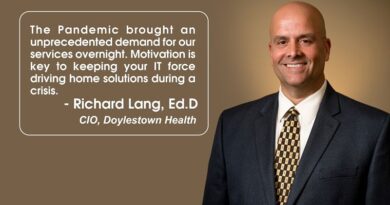COVID-19 Challenges and how Geisinger addressed it with the help of telemedicine
By David A. Fletcher, MBA, Associate Vice President Center for Telehealth, Geisinger
The COVID-19 pandemic has resulted in a sea change in the telehealth industry and brought about changes in the delivery of care that had been predicted to require years of transition in a matter of months. After regulations and payment models were altered to remove barriers to adoption, health systems across the country have increased the use of telemedicine more than tenfold in many cases. At its peak, Geisinger was completing more than twice as many video telemedicine visits in a single day as it previously did in an entire month. With the necessity of using telemedicine to provide care while observing social distancing, healthcare providers and patients have learned in mere months to become comfortable with the technology and are beginning to expect it. In survey data, Geisinger has noted many instances of patients stating that they hope these types of visits will continue to be available in the future.
This recent surge in telemedicine usage presents both new challenges and enormous opportunities to advance the state of telemedicine throughout the country. One such challenge is seeing patients in their homes for primary care, specialty, and subspecialty care visits. Prior to the pandemic, Geisinger conducted follow-up visits for surgery through a program called Geisinger at Home, in which nurses and community health assistants physically go to patients’ homes and use a tablet to connect to a centrally located physician. In response to the pandemic, with in-person elective clinic procedures temporarily halted, Geisinger was confronted with the challenge of seeing patients in their homes through telemedicine without the aid of a telepresenter. To address this need, we worked with our clinicians to identify the visit types that could be completed without physical contact and devices such as stethoscopes or otoscopes. We built those criteria into our scheduling decision trees. We were able to schedule more than 60% of our outpatient visits across more than 70 specialties. However, for the visits that require the aid of peripherals, the challenge remains: how do we see these patients in their homes? There are already a few home-based tools in the marketplace. With the massive increase in telemedicine volume, presumably, many medical supplies and telemedicine vendors will begin developing and marketing additional tools to health systems and directly to consumers. However, this solution brings about an additional challenge: how do we separate the wheat from the chaff, ensuring that patients and providers have access to meaningful data and that we don’t needlessly add costs to the system with well-marketed but low-value tools? In addition to vetting new technologies with internal telemedicine and IT specialists within Geisinger, we also cultivate relationships with telemedicine programs in health systems across the country and frequently share insights about products and services. By candidly sharing our experiences, we hope to help the industry better allocate resources to products that provide value to patients and providers.
Another challenge balanced with enormous opportunity brought about by the pandemic is the need to provide evidence to payers and policymakers of the effects of this sudden increase in telemedicine usage. Before COVID-19, it was challenging to demonstrate the efficiencies — or lack thereof — created by telemedicine because so few payers covered services provided in the home. Without evidence that telemedicine coverage wouldn’t result in a plus-one scenario, in which an episode traditionally handled by one office visit would be broken into a telemedicine visit and then followed up by another visit to the clinic, payers were reluctant to cover some of these services. Without payment coverage, health systems were not able to generate the data to prove or disprove those fears. However, with the urgent need brought about by the pandemic, many payers allowed services in the home for the first time, and health systems have been able to generate hundreds of thousands of claims across dozens of specialties. Geisinger plans to add to the understanding of telemedicine’s role as a tool in the healthcare system by studying the tens of thousands of telemedicine claims generated during 2020. Rather than looking for equivalence to clinic-based visits as many researchers have done in the past, we intend to look at the entire episode of care and determine whether patients were able to be treated with fewer visits, the same number, or more visits than they were when being seen in clinics. Due to a mix of several months in which clinics discontinued elective procedures and then restarted them, all while offering telemedicine visits, we can study the impact of in-home telemedicine options in several scenarios. We also intend to study any impact on the usage of emergency departments and urgent care clinics.
In response to the pandemic, with in-person elective clinic procedures temporarily halted, Geisinger was confronted with the challenge of seeing patients in their homes through telemedicine without the aid of a telepresenter
This time of incredible growth in telemedicine brings the potential to establish telemedicine as an important component of the healthcare system; however, it also brings the potential to generate doubt of the financial viability of telemedicine going forward. Therefore, we believe it is imperative that health systems share best practices and candidly discuss the benefits and limitations of new telehealth tools. Additionally, we must collect and distribute unbiased research of costs and outcomes in telemedicine and bring to light when telemedicine is indicated as a cost-effective tool for providers and patients — while also forthrightly describing times when it is not. Geisinger looks forward to studying these issues and welcomes the opportunity to work with other like-minded health systems.



